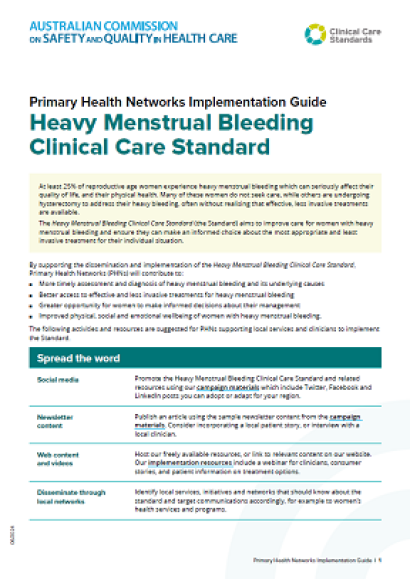Implementation guide for PHNs – Heavy Menstrual Bleeding Clinical Care Standard
Activities and resources for Primary Health Networks (PHNs) to support local services and clinicians using the Heavy Menstrual Bleeding Clinical Care Standard.
Primary Health Networks (PHNs) can play a key role in improving care for women with heavy menstrual bleeding. By helping to drive awareness, and supporting local clinicians and healthcare services to implement the care described in the Heavy Menstrual Bleeding Clinical Care Standard, PHNs will contribute to improvements in:
- Timely assessment and diagnosis of heavy menstrual bleeding and its underlying causes
- The physical, social and emotional wellbeing of women experiencing heavy menstrual bleeding
- Access to effective, less invasive treatment options for heavy menstrual bleeding
- Women’s ability to make informed choices about the treatments that are suitable for them.
The following activities and resources are recommended for PHNs supporting local services and clinicians to implement the Heavy Menstrual Bleeding Clinical Care Standard.
| Activity | Resource |
|---|---|
| Social media | Promote the Heavy Menstrual Bleeding Clinical Care Standard and related resources using our campaign materials which include X (formerly Twitter), Facebook and LinkedIn posts you can adopt or adapt for your region. |
| Newsletter content | Publish an article using the sample newsletter content from the campaign materials. Consider incorporating a local patient story, or interview with a local clinician. |
| Web content and videos | Host our freely available resources, or link to relevant content on our website. Our implementation resources include a webinar for clinicians, consumer stories, and patient information on treatment options. |
| Disseminate through local networks | Identify local services, initiatives and networks that should know about the standard and target communications accordingly, for example to women’s health services and programs. |
| Understand local data | Use the Commission’s interactive Women’s Health Focus Report to gain insight into the appropriateness of care for heavy menstrual bleeding in your region. See how local hysterectomy and endometrial ablation hospitalisations compare with other regions. Investigate reasons for, and possible responses to, unwarranted variation. |
| HealthPathways | Encourage your HealthPathways program to prioritise the localisation or review of your heavy menstrual bleeding pathway. The HealthPathways checklist for clinical editors summarises relevant components of the Standard and is presented so that relevant text can be incorporated directly into the pathway as/if appropriate. |
| Multidisciplinary education sessions |
Use the presentation for clinicians to support a local education event. Invite local experts to facilitate, such as a GP with special interest in women’s health and/or a gynaecologist. Incorporate information on local pathways and services to increase relevance and engagement. |

